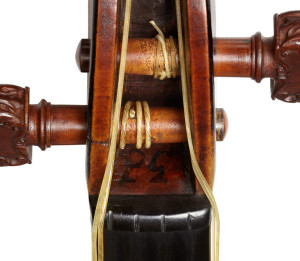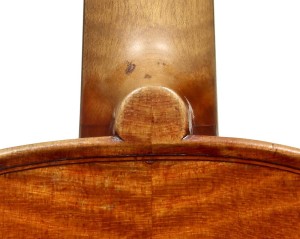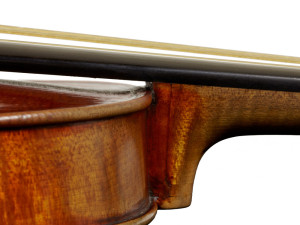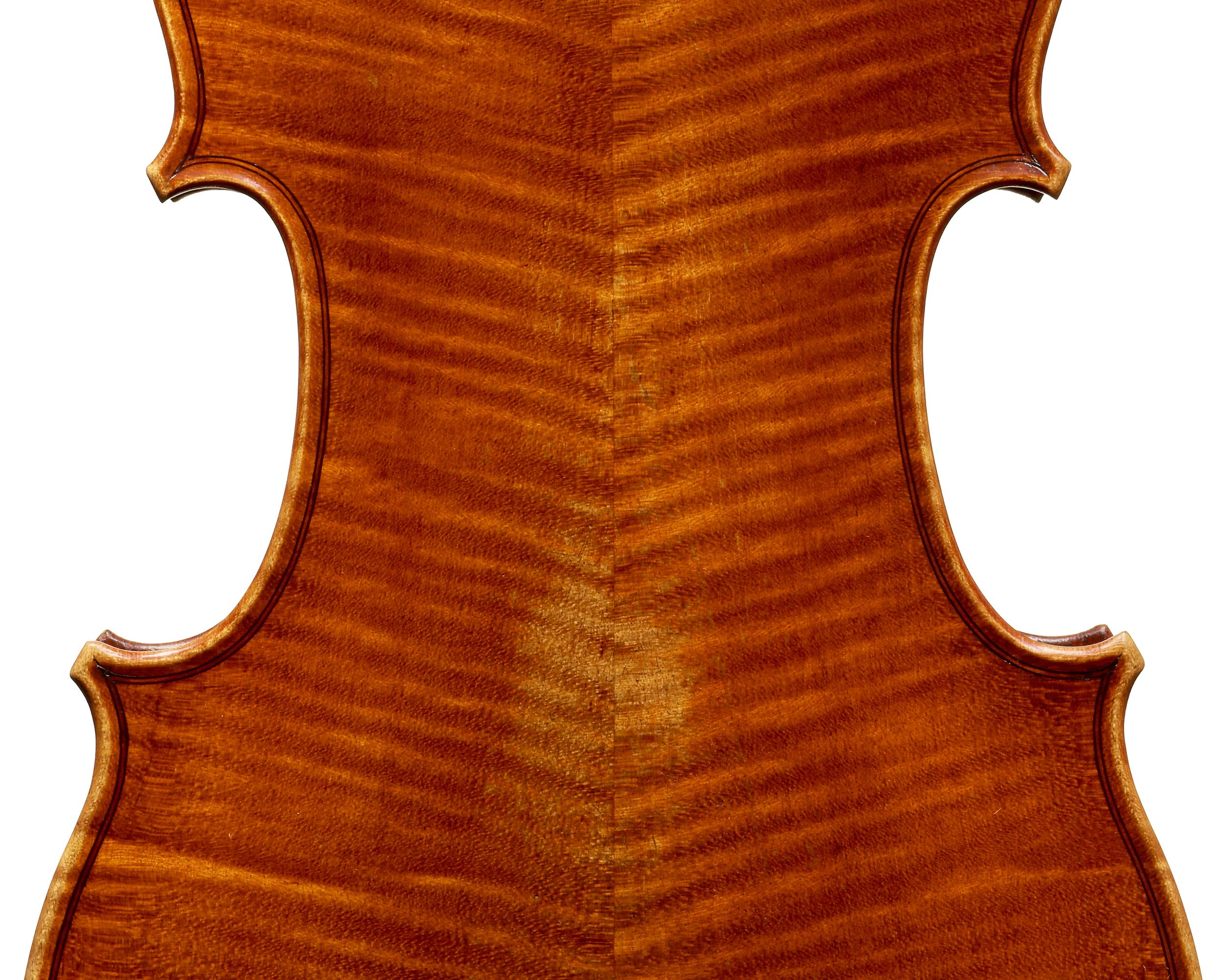The 1721 ‘Lady Blunt’ stands with the 1716 ‘Messiah’ above all other Stradivari violins in terms of its survival in near-perfect condition. In a way, the mythology that surrounds these two violins tends to overwhelm the objects themselves. It is a privilege for any violinist, maker, expert or enthusiast to view such an astonishing violin. At that moment, the words vanish and the violin proceeds to tell its own incredible story.
The ‘Lady Blunt’ has been cared for by several of the most responsible collectors and experts in history. Today it appears much as it did when it left the famous collection of the Parisian dealer Jean Baptiste Vuillaume in 1864; it still bears the ornamented pegs and tailpiece made in his workshop. Vuillaume wrote to the collector, C.H.C. Plowden in that year:
… as for myself, I am always on the lookout for fine instruments, they come and they go, that is business but when I possess fine examples I like to keep them as long as possible because I love them. At the present time, as extras, I have the Messie, an Amati, and a Guarnerius. All these are, however, beside the point; the most remarkable that I possess is a Stradivarius that is in new condition almost like the Messie. It is a rare discovery. This violin was brought to me from Spain in an unheard of condition with the neck, fingerboard and bass bar of Stradivari. It had never been opened, the reason being it had reposed, forgotten, in an attic for over 100 years… (translation)
Like the ‘Messiah’ the ‘Lady Blunt’ has had its original neck extended at the heel by Vuillaume. Fortunately Vuillaume was careful to leave the top untouched, without mortising the edge as is more common but also more destructive. He carefully retained the Stradivari fingerboard, which remains with the violin and shows unworn deposits of Stradivari varnish on its edges. He also replaced the bass bar with a longer, modern version, but retained the original, which also remains with the violin. Like the ‘Messiah’, the ‘Lady Blunt’s edges, corners and channelling allow us to observe the maker’s tool marks unaltered by any wear. Both violins have an almost unworn, full and magnificent varnish.
‘The most remarkable [violin] that I possess is a Stradivarius that is in new condition almost like the Messie. It is a rare discovery’ – J.B. Vuillaume
Inside the pegbox, at the base of the mortise, is the maker’s inscription ‘P G’, which indicates the violin was built on the ‘P G’ form. In the past this inscription was thought to be the initials of Paolo Stradivari but more recent scholars have demonstrated otherwise. The handwriting and letter form of the ‘P G’ in the pegbox of the ‘Lady Blunt’ exactly match the inscription on the ‘P G’ Stradivari form exhibited in the Museo Stradivariano in Cremona. The ‘P G’ (MS21) along with the ‘G’ (MS49) were the largest two violin forms Stradivari used during his mature years. The violins built on these forms are universally considered the most desirable.

Originally thought to have been ‘PS’, the inscription inside the pegbox is now understood to be ‘PG’
Of course, Stradivari’s violins have gained their fame not just for their appearance, but for their unparalleled tonal merits. Little has been written about the sound of the ‘Lady Blunt’, but this is not surprising as it is one of the few Stradivaris that has not been put to regular use. The violin retains its 19th-century set-up; even the bridge remains from W.E. Hill & Sons, who have been most closely associated with the violin since they first purchased it in 1896.
The ‘Lady Blunt’ has experienced few of the effects of constant playing that most 18th-century violins have suffered. Perspiration, wear, accidents, and unscrupulous repairs – even the most careful of musicians will leave his or her mark on a violin over the years. It is common knowledge that violins sound at their best when they are played regularly but the notion that they will spoil when they are unplayed is fortunately a myth. We are indeed lucky that the ‘Lady Blunt’ has been so well preserved and retains its full acoustic potential for future generations.
Provenance
The known history of the ‘Lady Blunt’ begins with Vuillaume, who according to Ernest Doring acquired it in Spain in 1860. Four years later he sold it on the recommendation of Leopold Jansa to his student, the Lady Anne Blunt. Lady Blunt was the daughter of the Earl of Lovelace and granddaughter of Lord Byron. She treasured the violin for over 30 years and sold it finally through Emil Hamma to the German dealer Edler in 1895. It was purchased by W.E. Hill & Sons the following year and sold immediately to their most important client, the collector Baron Johann Knoop. Arthur Hill wrote in his diary at that time:
Baron Knoop has purchased from us the Strad violin that reminds us so much of the ‘Messie’, as the varnish is of similar colour. It is in a very fine state, and for years we have cast longing eyes upon it. It is dated 1721, and Lady Anne Blunt bought it off Vuillaume of Paris. We have made drawings of the original fingerboard and bar of the violin, which are fortunately preserved for our Strad book.

The original button and the locating pin beneath the path of the purfling
Knoop parted with the violin in 1900 and shortly thereafter it was sold by Hills to Mr J.E. Street of Caterham, a celebrated amateur violinist and underwriter of Lloyds. Street purchased the violin for his son Edmund, who was a promising young violinist. The younger Street tragically died in the First World War; thereafter the violin was sold again by Hills in 1915 to the most important collector of his time, Richard Bennett. On Bennett’s death in 1930 the violin was purchased by Hills and remained in their collection until 1941. At this point they sold it through the dealer Robert Bower to the Swiss dealer and collector Henry Werro, who kept it for nearly 20 years. Werro produced a small monograph on the violin of which only 200 copies were published.
The violin was next sold in 1959 by Hills to the noted American collector, Sam Bloomfield. In 1971 Bloomfield auctioned it at Sotheby’s; it sold then for the record price of £84,500 to Hills on behalf of Robin Loh, the Singapore collector. Loh lent the violin to the 1987 Stradivari exhibition in Cremona organized by Charles Beare and kept the violin until 2000, when it was sold by Andrew Hill to a private collector.

The ‘Lady Blunt’ retains its original neck, re-angled at the heel by J.B. Vuillaume
The ‘Lady Blunt’ was more recently sold to the Nippon Foundation, again by their advisor, Andrew Hill. In 2011 it was sold on their behalf by Tarisio for another record price of £9.8 million ($15.9 million). All proceeds went to benefit the victims of the Japanese tsunami and earthquake.
